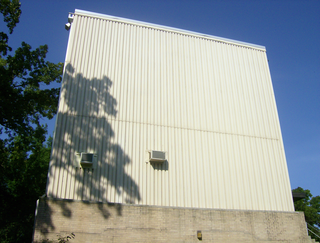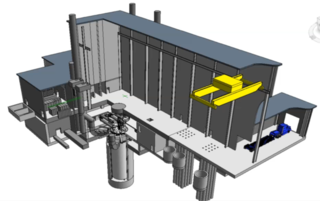
Neutron activation analysis (NAA) is a nuclear process used for determining the concentrations of elements in many materials. NAA allows discrete sampling of elements as it disregards the chemical form of a sample, and focuses solely on atomic nuclei. The method is based on neutron activation and thus requires a neutron source. The sample is bombarded with neutrons, causing its constituent elements to form radioactive isotopes. The radioactive emissions and radioactive decay paths for each element have long been studied and determined. Using this information, it is possible to study spectra of the emissions of the radioactive sample, and determine the concentrations of the various elements within it. A particular advantage of this technique is that it does not destroy the sample, and thus has been used for the analysis of works of art and historical artifacts. NAA can also be used to determine the activity of a radioactive sample.
PLUTO was a materials testing nuclear reactor housed at the Atomic Energy Research Establishment, a former Royal Air Force airfield at Harwell, Oxfordshire in the United Kingdom.

The Open-pool Australian lightwater reactor (OPAL) is a 20 megawatt (MW) swimming pool nuclear research reactor. Officially opened in April 2007, it replaced the High Flux Australian Reactor as Australia's only nuclear reactor, and is located at the Australian Nuclear Science and Technology Organisation (ANSTO) Research Establishment in Lucas Heights, New South Wales, a suburb of Sydney. Both OPAL and its predecessor have been commonly known simply as the Lucas Heights reactor.

The SLOWPOKE is a family of low-energy, tank-in-pool type nuclear research reactors designed by Atomic Energy of Canada Limited (AECL) beginning in the late 1960s. John W. Hilborn is the scientist most closely associated with their design. They are beryllium-reflected with a very low critical mass, but provide neutron fluxes higher than available from a small particle accelerator or other radioactive sources.

A swimming pool reactor, also called an open pool reactor, is a type of nuclear reactor that has a core immersed in an open pool usually of water.

The High Flux Isotope Reactor (HFIR) is a nuclear research reactor at Oak Ridge National Laboratory (ORNL) in Oak Ridge, Tennessee, United States. Operating at 85 MW, HFIR is one of the highest flux reactor-based sources of neutrons for condensed matter physics research in the United States, and it has one of the highest steady-state neutron fluxes of any research reactor in the world. The thermal and cold neutrons produced by HFIR are used to study physics, chemistry, materials science, engineering, and biology. The intense neutron flux, constant power density, and constant-length fuel cycles are used by more than 500 researchers each year for neutron scattering research into the fundamental properties of condensed matter. HFIR has about 600 users each year for both scattering and in-core research.

North Carolina State University in 1950 founded the first university-based reactor program and Nuclear Engineering curriculum in the United States. The program continues in the early 21st century. That year, NC State College administrators approved construction of a reactor and the establishment of a collegiate nuclear engineering program. The first research reactor was completed in 1953; it was scaled up in 1957 and 1960. It was deactivated in 1973 to make way for the PULSTAR reactor. The old reactor has been decommissioned.
There are two nuclear research reactors that serve the Texas A&M University Nuclear Science Center. The older of the two is the AGN-201M model, a low-power teaching reactor. The newer reactor, the TRIGA Mark I, is focused strongly towards research.
The Pennsylvania State University (PSU) Radiation Science & Engineering Center (RSEC) houses the Breazeale Nuclear Reactor (BNR). This reactor is the oldest operating in the nation and has undergone numerous power upgrades, renovations, and other changes. The reactor serves the research purposes of the Penn State Department of Mechanical and Nuclear Engineering as well as researchers from industry and other universities. Its total licensed thermal output is 1.1 MW, however the reactor is procedurally limited to 1.0 MW (for 100% operation).

The Oregon State University Radiation Center (OSURC) is a research facility that houses a nuclear reactor at Oregon State University (OSU) in Corvallis, Oregon, United States. The Oregon State TRIGA Reactor (OSTR) serves the research needs of the OSU nuclear engineering department along with other departments.

The University of Florida Training Reactor (UFTR), commissioned in 1959, is a 100 kW modified Argonaut-type reactor at the University of Florida in Gainesville, Florida. It is a light water and graphite moderated, graphite reflected, light water cooled reactor designed and used primarily for training and nuclear research related activities. The reactor is licensed by the Nuclear Regulatory Commission and is the only research reactor in Florida.
The Ford Nuclear Reactor was a facility at the University of Michigan in Ann Arbor dedicated to investigating the peaceful uses of nuclear power. It was a part of the Michigan Memorial Phoenix Project, a living memorial created to honor the casualties of World War II. The reactor operated from September 1957 until July 3, 2003. During its operation, the FNR was used to study medicine, cellular biology, chemistry, physics, mineralogy, archeology, anthropology, and nuclear science.
In the field of nuclear engineering, a rabbit is a pneumatically controlled tool used to insert small samples of material inside the core of a nuclear reactor, usually for the purpose of studying the effect of irradiation on the material. Some rabbits have special linings to screen out certain types of neutrons.

The Missouri University of Science and Technology Nuclear Reactor is a swimming pool type nuclear reactor operated by the Missouri University of Science and Technology. It first achieved criticality in 1961, making it the first operational nuclear reactor in the state of Missouri. Missouri S&T operates this reactor for training, education, and research purposes.

The Washington State University Reactor (WSUR) is housed in the Dodgen Research Facility, and was completed in 1961. The (then) Washington State College Reactor was the brainchild of Harold W. Dodgen, a former researcher on the Manhattan Project where he earned his PhD from 1943 to 1946. He secured funding for the ambitious 'Reactor Project' from the National Science Foundation, the Atomic Energy Commission, and the College administration totaling $479,000. Dodgen's basis for constructing a reactor was that the College was primely located as a training facility for the Hanford site, as well as Idaho National Laboratory because there was no other research reactor in the West at that time. After completing the extensive application and design process with the help of contractors from General Electric they broke ground in August 1957 and the first criticality was achieved on March 7, 1961 at a power level of 1W. They gradually increased power over the next year to achieve their maximum licensed operating power of 100 kW.

The Materials Testing Reactor (MTR) was an early nuclear reactor specifically designed to facilitate the conception and the design of future reactors. It produced much of the foundational irradiation data that underlies the nuclear power industry. It operated in Idaho at the National Reactor Testing Station from 1952 to 1970.
ETRR-1 or ET-RR-1, is the first nuclear reactor in Egypt supplied by the USSR in 1958. The reactor is owned and operated by Egyptian Atomic Energy Authority (AEA) at the Nuclear Research Center in Inshas, 40–60 kilometres (25–37 mi) northeast of Cairo.
ETRR-2 or ET-RR-2, or is the second nuclear reactor in Egypt supplied by the Argentine company Investigacion Aplicada (INVAP) in 1992. The reactor is owned and operated by Egyptian Atomic Energy Authority (EAEA) at the Nuclear Research Center in Inshas, 60 kilometres (37 mi) northeast of Cairo.

FiR 1 was Finland's first nuclear reactor. It was a research reactor that was located in the Otaniemi campus area in the city of Espoo. The TRIGA Mark II reactor had a thermal power of 250 kilowatts. It started operation in 1962, and it was permanently shut down in 2015. At first, the reactor was operated by Helsinki University of Technology (TKK), and since 1971 by VTT Technical Research Centre of Finland.

The Versatile Test Reactor (VTR) was a project by the U.S. Department of Energy to build a fast-neutron test reactor by 2026. Funding for the project was scrapped in 2022













